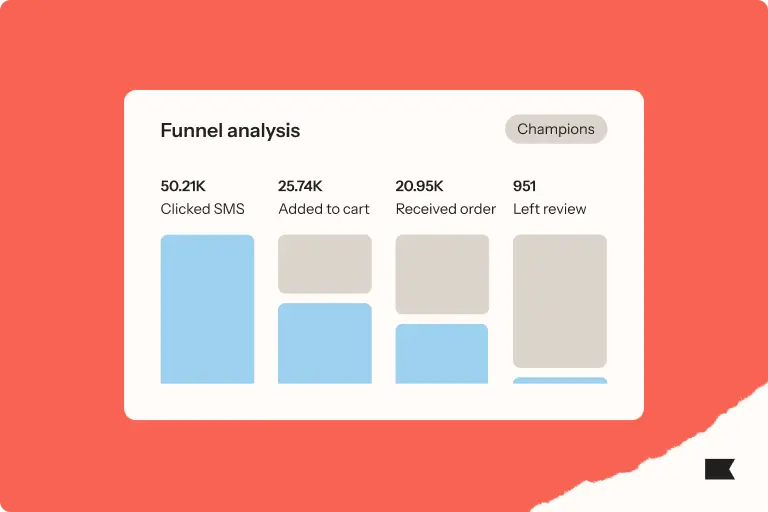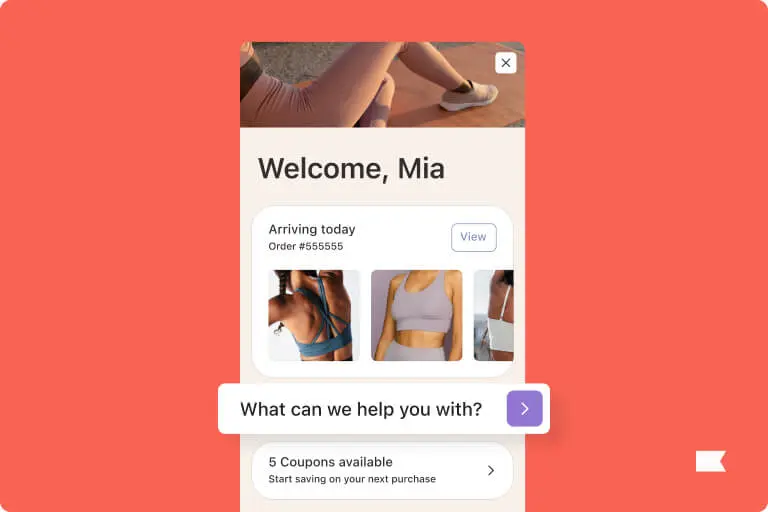Behavioural targeting strategy: how it works—and how to use Klaviyo to do it ethically
We’ve all had that moment after having a casual conversation when we open our phones, start scrolling…
…and immediately see an advertisement for the exact thing we were just talking about.
Blame it on the dark side of behavioural targeting.
At its best, behavioural targeting has the power to bring shoppers back to your store, get them to engage with your content, and convince them to take whatever action you most want them to take—driving higher user engagement, conversion rates, and marketing return on investment.
But at its worst, it can cross boundaries many consumers hold sacred.
As marketers continue to adjust the way they learn about and communicate with their customers in the wake of Apple’s iOS privacy updates and data privacy regulations like the GDPR and CTIA, behavioural targeting based on third-party cookies and tracking pixels may raise ethical issues—and, just as concerning, wind up scaring people off in a way you find it tough to come back from.
We don’t want to creep anybody out. So how do we do all of this, and make it a really personalised experience, without coming across as Big Brother?
“We don’t want to creep anybody out,” says Sean Donahue, director of email marketing at nationally recognised digital marketing agency Power Digital. “So how do we do all of this, and make it a really personalised experience, without coming across as Big Brother?”
The answer, experts agree, lies in the type of data that’s driving your behavioural marketing strategy.
“The market is moving away from third-party data,” says Jon Palmer, lead product marketing manager at Klaviyo. “Marketing activities based on third-party data, like purchasing lists or understanding what other websites someone’s been to in the same session, are, in places like the EU and California, already on their way out.”
The market is moving away from third-party data.
“Even if, in the short term, third-party data helps you get in front of more customers or identify a slightly higher percentage of shoppers, we have run side-by-side tests that show those additionally identified people don’t re-translate to more revenue,” Palmer cautions. “In the coming years, it’s not even going to be an option.”
When behavioural targeting is based, instead, on zero- and first-party data, it means consumers have explicitly consented to sharing their personal information with your brand. “And that data’s always going to be safe and ethical to use,” Palmer says.
Read on to learn what ethical behavioural targeting looks like in practice—and how Klaviyo helps you reap the benefits of behavioural targeting by keeping your practices above board.
How behavioural targeting works, in 3 steps
Unlike contextual targeting, which aligns online advertising with the webpages on which those ads appear, behavioural targeting uses the recent and historical activities of your subscribers, customers, and potential customers to determine the kind of messaging you send them next.
Customer takes action, marketer observes action, marketer uses technology to personalise content based on that action—at scale for all their subscribers.
The beauty of behavioural targeting is that it’s based on facts, not assumptions. It goes beyond context and demographics to reach consumers with digital advertising tailored to their actual, individual track records with your brand.
Palmer sums up how behavioural targeting works this way: “Customer takes action, marketer observes action, marketer uses technology to personalise content based on that action—at scale for all their subscribers.”
Let’s break down that process step by step.
Step 1: Data collection
Once someone has signed up to a marketing list and consented to receive marketing material, “that enables us to capture first-party behavioural data from them,” explains Devin Bhatia, principal customer success manager at Klaviyo.
We’re aware when they’re going through the ecommerce shopping experience—when they’re active on site, when they’re viewing a product, when they’re starting a check-out or placing an order.”
What that means in practice, Bhatia says, “is we’re aware when they’re going through the ecommerce shopping experience—when they’re active on site, when they’re viewing a product, when they’re starting a check-out or placing an order.”
Base your behavioural targeting strategy on the customer data you collect from these 4 primary channels or platforms through which your target audience interacts with your brand:
- Website and browsing behaviour: How are people finding your site? What are they searching for? How long do they typically spend there? What seems to make them linger or leave?
- Email and SMS engagement: What emails and text messages are your subscribers opening? What are they clicking on? When are they engaging? What’s making them bounce or unsubscribe?
- Purchase behaviour: What products are customers spending the most money on? What’s their lifetime value? What’s their average order value? Which SKU did they buy?
- Mobile app activity: How much time are people spending in your app? How many people have downloaded your app, but haven’t opened it in the last month? Who’s subscribed to push notifications?
The challenge is uniting all of that data together so that you understand the entire scope of a customer’s behaviour, rather than just isolated data points. And with a lot of marketing platforms, that’s either not possible, or it’s very cumbersome.
With a unified, holistic view of your customer, you can speak to them more accurately and more effectively.
A customer data platform (CDP) like Klaviyo pulls all that data together into a single customer view, “painting a cohesive picture,” says Anthony DelPizzo, product marketing lead, Klaviyo CDP. “That’s super, super valuable. With a unified, holistic view of your customer, you can speak to them more accurately and more effectively.”
Step 2: Audience segmentation
Once you have a comprehensive understanding of your customers, “segmentation narrows your focus and helps you find the right people to target given the situation,” Bhatia explains.
Segmentation is the fastest way to group your contacts into ultra-precise audiences based on user behaviour. The most granular segmentation—and “true 1:1 marketing,” Palmer says—involves marketing automation, in which a customer takes an action and a marketing message is triggered by that action.
People hear ‘segmentation’ and they hear, ‘I’m going to send this to fewer people.’ And yes, that may be true, but you’re sending to the right people who are going to give you greater overall results.
With the right marketing automation provider, your segments update in real time—so you can target messages based on whatever customer behavioural patterns you’ve determined are important to your brand.
Here are just a few ultra-specific segmentation ideas, based on real-life Klaviyo use cases and the ethical data sources outlined above:
- Website visitors who are already subscribed to your email list
- Site visitors who arrive from a specific acquisition source
- Email subscribers who clicked an email in the last 72 hours but have not placed an order
- Email subscribers who add a product to their cart, but do not click on the cart or proceed to check-out
- Customers who only purchase during Black Friday
- Customers who have purchased a specific product in the last year
- Customers who have purchased a specific product in the last year and also left a review, either positive or negative
- SMS subscribers who have purchased twice in the last 6 months and have spent at least 3x your AOV
- Customers with high CLTV who aren’t subscribed to any of your owned marketing lists
- Lapsed customers with high CLTV who are also at a high risk of churn
Jen Brennan, director of digital marketing at Northern, thinks segmentation has an unfairly bad rap. “People hear ‘segmentation’ and they hear, ‘I’m going to send this to fewer people.’ And yes, that may be true, but you’re sending to the right people who are going to give you greater overall results.”
Step 3: Personalised marketing
Segmentation is what helps you create marketing moments that appeal to your customers personally—and relevant, personalised marketing moments are what show your customers you care about them as human beings, not just dollar signs.
Having that type of information, and also knowing where each person is within the customer journey, gives us the ability to deliver the most relevant messaging possible.
With behavioural targeting, you can send each of your carefully chosen segments targeted marketing messages that specifically relate back to consumer behaviours. That might come in the form of:
- Personalised on-site forms
- Personalised email campaigns and automations
- Personalised SMS marketing campaigns and automations
- Personalised mobile push notifications
- Your retargeting/remarketing strategy, in which you use the insights you gather to deliver personalised ads that align with the interests of your customers all over the web
If you consistently communicate with your subscribers in a way that makes it clear you know what they want, they’re more likely to trust your brand—and that’s “where you pivot into more of the retention and CLTV conversation,” Brennan points out.
“Having that type of information, and also knowing where each person is within the customer journey, gives us the ability to deliver the most relevant messaging possible,” Bhatia agrees. “And Klaviyo makes that very easy.”
Bhatia says Klaviyo’s user-friendly interface is particularly useful in both understanding “more about those individual segments” and determining the right cadence and content for connecting with them.
That’s what separates Klaviyo from the competition—the fact that we’ve democratised the process.
Competing platforms might show you that someone abandoned their shopping cart or placed an order, for example. “But it wouldn’t be easy to branch the flows based on the cart value, or to create a segment based on people who bought a size-8 black shoe,” Palmer explains.
“That’s what separates Klaviyo from the competition—the fact that we’ve democratised the process,” agrees Lucina Kress Rowe, principal customer success manager at Klaviyo. “You can do all these sophisticated things, and they’re not complicated. It’s just part of the norm.”
How to use Klaviyo to keep your behavioural targeting ethical
Remember: As regulators and private companies become increasingly protective of consumer data, it’s becoming more and more difficult to easily and inexpensively use third-party advertising to get in front of new audiences.
“Everyone’s so concerned about tracking—about their personal data and what’s happening with their data. And they should be,” Kress Rowe says. “But it’s less of an issue when it’s first-party data. With first-party data, people have opted in. They’ve explicitly told you, ‘Yes, I’d like to receive your communications.’ And that makes for smarter communications.”
There are definitely ethical issues with behavioural targeting, but I believe those issues are specifically related to individuals who have not consented to receive marketing from a retailer, and then they do. Klaviyo never wants to foster that experience.
“There are definitely ethical issues with behavioural targeting, but I believe those issues are specifically related to individuals who have not consented to receive marketing from a retailer, and then they do,” Bhatia agrees. “That can lead to a disingenuous user experience, and it can give marketing and advertising a bad name overall.”
“Klaviyo never wants to foster that experience,” Bhatia adds.
1. Lean on your marketing provider or agency for guidance
Kress Rowe believes that having access to both first-party data and “either a tool or a person who can coach you” on the ethics involved is what keeps behavioural targeting above board.
That guidance makes it so that the touch is appropriate to that situation. And then you’ve got the best of both worlds.
“When we’re working with a client, we might say, ‘Hey, this should probably be a light touch. On this one we don’t want you sending any more than two messages. Have you thought about that? That seems a little bit heavy,’” Kress Rowe explains. “That guidance makes it so that the touch is appropriate to that situation. And then you’ve got the best of both worlds.”
2. Respect people’s boundaries
“We really try to protect that end consumer,” agrees Bhatia, who shares a few other behavioural targeting best practices for respecting the privacy of your subscribers:
- Treat all unsubscribes as global unsubscribe (meaning if someone unsubscribes from your newsletter, they also won’t receive an abandoned cart flow in the future)—Klaviyo does this by default.
- Send fewer emails to more engaged audiences.
- Send only to email addresses that have consented to receive marketing materials, which does not include everyone who’s inputted their email address when placing an order.
- Be transparent about how you’re using subscribers’ data.
- Always provide clear opt-out options.
3. Be helpful
Finally, never forget that the goal of behavioural targeting isn’t necessarily to sell more products, or even get more people to click on your emails and texts. It’s to connect with your customers in a way that makes them feel seen, not targeted. (The rest will follow.)
“Be helpful,” Donahue says. “Be there for the customer when they need you, and not when they don’t. Marketing automation is about finding those opportunities—making sure you’re in the right place at the right time, and not where you shouldn’t be.”
Be helpful. Be there for the customer when they need you, and not when they don’t. Marketing automation is about finding those opportunities—making sure you’re in the right place at the right time, and not where you shouldn’t be.
Behavioural targeting strategy FAQs
How does behavioural targeting work?
Behavioural targeting involves mining for insights within your consumer data, which can then help you not only more appropriately segment your subscriber lists, but also fine-tune the messaging and content you’re sharing through each channel—thus driving engagement, conversions, and long-term loyalty.
What companies should use behavioural targeting?
By delivering the personalised marketing today’s consumer craves, behavioural targeting not only improves the customer experience and therefore your brand reputation. It also drives higher open rates, click rates, and conversion rates among shoppers who are more likely to keep coming back beyond a one-time purchase—which means it can benefit almost any company that communicates digitally with customers.
What are examples of behavioural segments?
A few examples of behavioural segments include:
- Website visitors who are already subscribed to your email list
- Email subscribers who clicked an email in the last 72 hours but have not placed an order
- Customers who only purchase during Black Friday
- Customers who have purchased a specific product in the last year and also left a review, either positive or negative
- SMS subscribers who have purchased twice in the last 6 months and have spent at least 3x your AOV

Related content

Learn how to use Klaviyo data to improve personalisation, enhance customer journeys, and boost engagement for long-term retention.

Learn about customer segmentation examples that can boost your marketing strategy, improve engagement, and drive revenue.

Discover how ecommerce personalisation enhances customer experiences and boosts revenue with real examples and proven strategies.